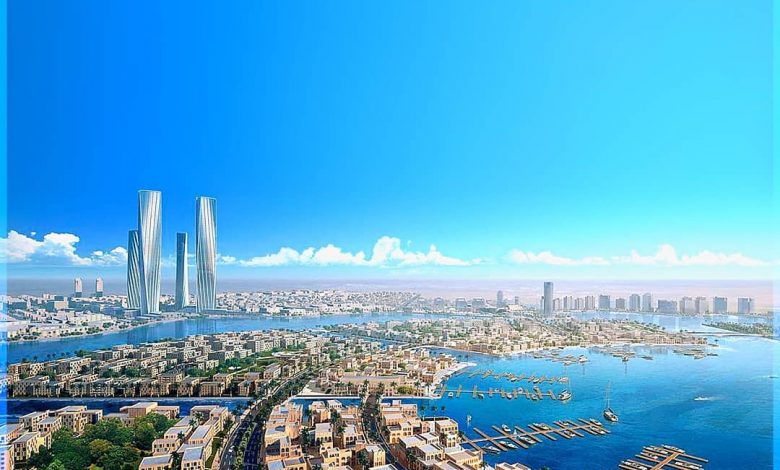
TheLusail.com
The iconic Lusail Stadium – one of only ten built in the small country to prepare for the World Cup – designed by the venerable British architect Norman Foster will have zero carbon footprint and will be powered entirely by solar energy and will use a range of 500,000 devices known as artificial clouds to protect the stadium from the sun. But if the ultimate issue is whether or not to build the stadium, it will be in the city of Lusail, a huge planned community that is expected to be completed in 2020 at an estimated cost of $4.5 billion.
As you may know, the 2022 World Cup in the Middle East is to be held in Qatar. The country is spending $4.5 billion to build Lusail, an entirely new city from scratch. It will have a population of 260,000 people.
The new city will be a luxurious center surrounded by crystal clear Gulf waters, with dozens of brand new neighborhoods and a rapid infrastructure system. Luxury villas, a marina and a waterfront marketplace will also be built. If the project goes according to plan, Qatar will see a picture of ease, leisure and efficiency.
The central hub of Lusail will be retail and office space. Luzhniki Stadium will be built in the new Luzhniki City development at the northern edge of Doha on the coast of the Persian Gulf around 20 kilometres south of central Doha. It will be a self-contained mixed housing development with commercial and retail properties, with an estimated population of 200,000.
The Lusail Stadium is located in the heart of Lusail, a planned coastal city in the northern part of the commune of Al Daayen. The city of Luzhniki, built from scratch and the flagship of the Government’s Sustainable Development Plan Vision 2030, will include a number of features, including water-sensitive landscaping and a planned district cooling system designed to save 6.5 million tonnes of CO2 annually.
Developers hope to finish Lusail by 2019, three years before Qatar is due to become the first Arab nation to host the World Cup. There will be 20,000 workers, and the small town itself will be built around the city at an estimated cost of $4.5 billion. The city, which will be Qatar’s second largest city, will have a capacity of 80,000 and Lusail Stadium will be a major tournament site when the World Cup in Qatar takes place in 2022 in November.

After Qatar received the hosting rights for the 2022 World Cup, it was decided to build a huge stadium in Lusail. Whatever the outcome, the legendary Lusail Stadium will host the opening and closing matches of the World Cup 2022 with a capacity of 86,250 spectators.
Eight venues have already been chosen, including star architect Zaha Hadid’s controversial stadium and the Honor. The project, which will host the opening ceremony and closing ceremonies, will seat 80,000 and is expected to be Qatar’s largest World Cup arena.
On the sand of the Qatari coast rises a tower of glass, steel and concrete that will form Lusail, a city built from scratch. It is Pharaonic in scope and ambition, the vision of former emir of Qatar, Sheikh Hamad bin Khalifa al-Thani, and was born in part out of a desire to diversify the Qatari economy and to dissociate itself from oil dependency. It is a new city designed by international developer Qatari Dinar. Located on Qatar’s west coast, nine miles from Doha, it is estimated to cost $4.5 billion and will house 400,000 people.
That is precisely what the Qatari government and its developers are trying to do with Lusail, an ambitious planned 28-square-kilometer waterfront city in the Persian Gulf desert. It is a city almost entirely built from scratch, funded by the government and Qatari Dinar Real Estate Company and designed in 2005 as a development that the country would adopt following the announcement of being the 2022 World Cup host. The city under construction will include a business district, a lagoon, four islands, two marinas, upscale shopping centers, a hospital, a zoo and two golf courses and will accommodate 250,000 people.
There will be a light rail network, a water taxi and a network of underground pedestrian tunnels for residents and visitors. An 86,000-seat football stadium is to host the 2022 FIFA World Cup final, complete with a solar-powered cooling system that provides a respite from the summer heat.
Foster Partners designed the stadium after it was awarded the Qatar bid in 2010, along with several others. The Main Stadium for World Cup 2022 in Qatar will host the tournament’s opening and closing ceremonies and its pioneering design aims to take the stadium design to the next level. By creating a standing object similar to the Bird’s Nest at the University of Phoenix Stadium, Foster Partners anticipates a future urban network linking the stadium to future cities.
Qatar, which will host the 2022 World Cup, is not just a big country with a population of 21 million. Great efforts have been made to prepare for the millions that will pour into the country in eight years “time, including the construction of an entire new city from scratch. The first Qatari Diar Triathlon will take place in spring 2019 on the promenade of Lusail City Marina.




